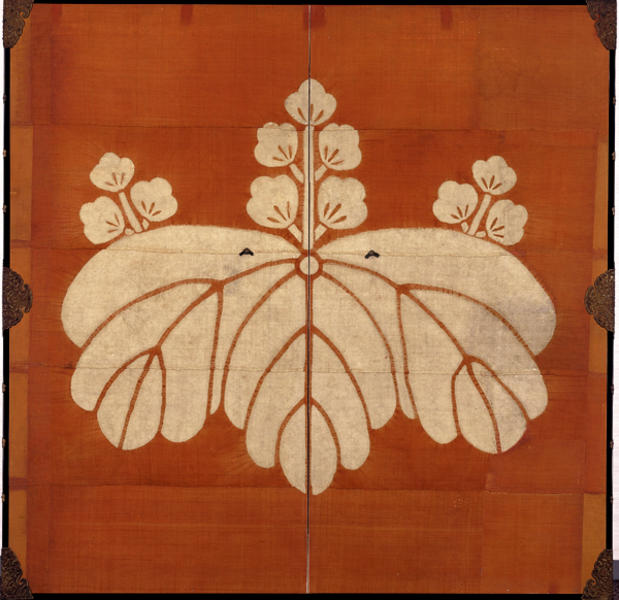桐紋陣幕屏風
- 桃山時代
- 二曲屏風一隻、茜染紬風平絹織
- H-182 W-185
- 所蔵
- 長尾美術館旧蔵
桃山時代 16世紀
茜染紬風平絹織
縦:182.0cm 横:185.0cm
桐紋を絞り染めした陣幕の断片を二曲屏風に仕立てたもの。茜染によると思われる赤地平絹に大きな桐紋一つを白揚げで表している。裂幅40センチメートルほどの紬風平絹五幅を横についで絹撚糸で縫合(縫糸は後補)した五幅幕である。桐紋は横が153センチメートル,縦が129センチメートルの大きさで一段目から五段目に及ぶ。紋は縫い絞りの技法によるもので,絞足の一部に縫い締めの麻糸が残っている。縫い締めの針目は比較的細かい。桐紋の中央部,二段目と三段目の縫い目の二カ所に藍韋を熨斗結びにして縫いつける。これは本来縫い目の一部を開け,風抜きの孔とした「物見」の跡であるが,現状ではこの孔の部分も縫合されている。一段目の上辺には約40センチメートル間隔で乳付の縫い跡が残る。
陣幕は中世から近世を通じて制作され,寸法や仕立て,家紋の数や大きさなどに故実が生じた。この陣幕はすでに断片化しているため,幕の全容を知りえないが,本来は全長が少なくとも二丈五尺(約760センチメートル)以上に及び,そこに五つの桐紋を表した五幅幕であったと考えられる。
伝承によれば,この陣幕は豊臣秀吉が醍醐の花見に用いたものという。五幅にわたる堂々とした五七の桐紋は,伊勢貞丈の『軍用記』(宝暦11年)に「大将の幕は上下の幅迄にかかる也」と見えるごとく,秀吉の所用にふさわしいものと言えよう。桐紋は,麻糸で針目細かく縫い締めて防染し,白く揚げたもので,桃山時代に盛んに行われた,いわゆる「辻が花」に通じる技法を示している。 (河上)
Catalogue Entry
Momoyama period, 16th century
2-panel screen, shibori resist dye on silk
Height, 182.0cm; width, 185.0cm
A fragment of a curtain for outdoor use with a shibori tie-dyed pattern of paulownia crest has been mounted as a 2-panel screen. The red of the plain-weave silk was probably achieved with red-madder (Rubia cordifolia) dye, and one large paulownia crest has been created in resist as a white form on the red ground. 5 lengths of approximately 40cm-wide pongee-like plain silk have been stacked horizontally and joined along their selvages by silk stitching to create a 5 panel curtain (the joining threads are a later addition). The paulownia crest is 153cm wide and some 129cm tall, stretching from the top rank of fabric to the 5th. The crest was created through the stitched shibori method, and traces of the binding linen threads remain in some of the shibori knot areas. The needle holes for the shibori knotting are relatively small. 2 small indigo decorative knots have been stitched in the center of the paulownia crest, placed on the seam between the 2nd and 3rd panels. These are traces of "peep-holes" that would have been opened as wind breaks along a section of the seams, and at present these holes have been stitched shut. Traces of small attachments placed at 40cm intervals can be found along the top edge of the top panel of silk.
Such curtains for outdoor use were produced from Japan's medieval period through its pre-modern period, and specific customs developed about the measurements, construction method, number and size of family crests displayed, and other elements of these curtains. This fragment of a curtain had already been detached from its original format, and hence the overall structure of the curtain cannot be determined, but it was likely that this was a 5-width curtain at the very least, over 2 jo 5 shaku in width (approximately 760cm).
According to the traditions associated with this work, this curtain was used by Toyotomi Hideyoshi at his famous Daigo flower-viewing party. The 5 or 7 paulownia crests that would have magnificently adorned the 5-width curtain, as seen in Ise Sadatake's Gunyoi (Horeki 11, 1761) description of the width and breadth of the great leader's curtain, would have been appropriate for use by Hideyoshi.
Here the paulownia crest was created in white resist by setting fine stitches of linen threads into the cloth and is an example of the tsujigahana technique that was popular throughout the Momoyama period. KS
